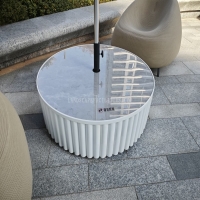Welcome to the website for landscape facilities products and knowledge.
How do landscape tables align with sustainable urban development goals?
Landscape tables, as innovative elements in urban design, play a pivotal role in aligning with sustainable urban development goals. These multifunctional structures combine aesthetics with functionality, offering seating, greenery, and social interaction spaces while addressing environmental challenges.
One key benefit is their contribution to green infrastructure. By incorporating plants and permeable surfaces, landscape tables mitigate urban heat islands, improve air quality, and manage stormwater runoff. Their design often utilizes recycled or sustainable materials, reducing the carbon footprint of urban furniture.
Moreover, landscape tables foster community engagement. Placed in parks, plazas, or transit areas, they encourage social interaction and outdoor activities, enhancing the livability of cities. Their adaptable designs can also support biodiversity by integrating native plant species.
From a planning perspective, landscape tables exemplify the "placemaking" approach, transforming underutilized spaces into vibrant, eco-conscious hubs. Cities prioritizing such solutions demonstrate commitment to the United Nations' Sustainable Development Goals (SDGs), particularly Goal 11 (Sustainable Cities and Communities).
As urban areas continue to grow, landscape tables represent a simple yet effective tool for creating resilient, people-centric environments that balance development with ecological preservation. Their widespread adoption signals a shift toward more thoughtful, sustainable urban furniture solutions.
Related search:

Recommendation
Round metal tube border design table with tempered glass or granite countertop on the top.